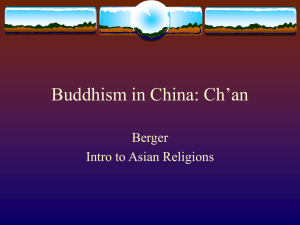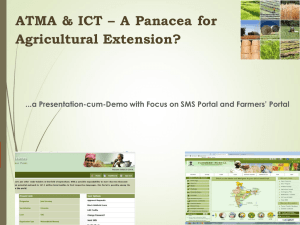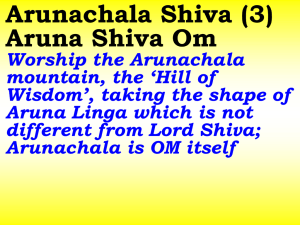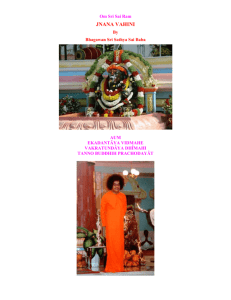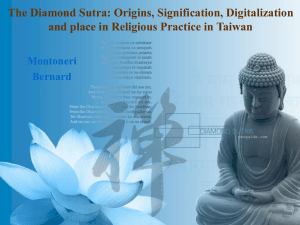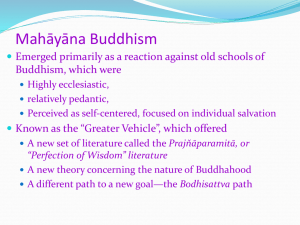related to the talk (.pdf file)
advertisement
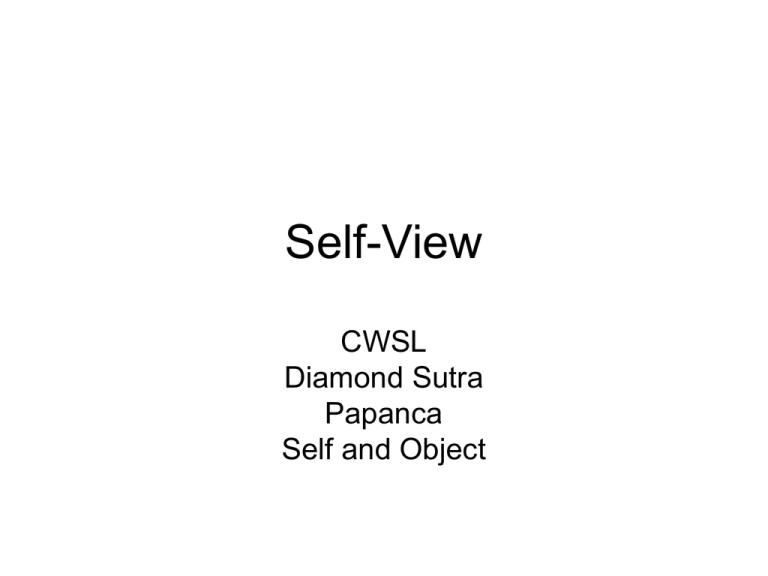
Self-View CWSL Diamond Sutra Papanca Self and Object Empty the Mind of: 1. 2. 3. 4. Selfishness Self-conceit Self-cherishing Self-delusion Cultivate a Mind of: 1. 2. 3. 4. Loving Kindness Compassion Altruistic Joy Equanimity Manas 末那 mònà Manas, 末那 (mònà), the 7th part of consciousness responsible for creating the illusory conceptualization of the Self, refers directly to the Four Selfishnesses: Klesas caturbhih sahitam nivrtavyakrtaih sada Atmadrstyaatmamohatmanmanatmasnehasmjnitaih. (Atmadrstya—atmamoh[a]—atmanman[a]—atmasneha) Self-belief (atmadrsti), Self-delusion (atmamoha), Self-conceit (atmamana), and Self-Love (atmasneha). [Notice that the Chinese reverses the order of the first two. The full verse in English, translated from the Chinese in the 30 Verses of Vasubandhu, is as the following. ‘It’ refers to the Manas Consciousness. Wat translation in CWSL follows:] It is always accompanied by four klesas or vexing passions (sources of affliction and delusion), Namely, Self-delusion (atmamoha), Self-belief (atmadrsti) Together with Self-conceit (atmamana), and Self-Love (atmasneha). It is accompanied by the other mental associates (caittas), Namely, mental contact (Sparsa), and so forth [attention, sensations, conceptions, and volition]. Xuanzang’s Cheng Wei Shi Lun View of the Manas Atma moha Atma drsti Atma mana Atma sneha Chinese 我癡 我見 我慢 我愛 wǒchī SelfDelusion wǒjiàn SelfBelief wǒmàn SelfConceit wǒài SelfLove SelfDelusion SelfView SelfIdentity SelfLove Sanskrit Pinyin Wat Translation CWSL Muller Translation CWSL compared with Diamond Sutra Sanskrit Atma moha Atma -drsti Atma mana Atma sneha CWSL SelfDelusion SelfBelief SelfConceit Chinese Pinyin 我癡 我見 我慢 Self[cherishing] Love Wǒchī Wǒjiàn Wǒmàn 我愛 wǒài Diamond Sutra Chapter 31 person view self view life span view 人見 我見 living-being view renjiàn wǒjiàn 衆生見 shou zhě jian Red Pine View of a self Wat Translation Commentary 壽者見 zhong shēng jiàn View of a being View of a life View of a soul Vasubandhu compared with Diamond Sutra Atma -moha Atma – drsti Atma mana Atma sneha SelfDelusion SelfBelief SelfConceit Chinese Pinyin 我癡 我見 我慢 Self[cherishing] Love Wǒchī Wǒjiàn Wǒmàn 我愛 wǒài Diamond Sutra Chapter 31 person view 人見 renjiàn self view 我見 livingbeing view 衆生見 life span view 壽者見 Sanskrit 30 Verses CWSL Wat Translation wǒjiàn zhong shēng jiàn shou zhě jian Papanca, CWSL, and Diamond Sutra Papanca Bhikkhu Nananada CWSL Sanskrit Chinese Pinyin CWSL Wat Translation Diamond Sutra last chapter 3) Ditthi – Views 見 jiàn Atma Atma moha drsti 2) Mana – 1) Tanha Conceit Craving 慢 màn 渇 kě 愛 ài Atma Atma mana sneha 我癡 我見 我慢 我愛 wǒchī SelfDelusion wǒjiàn SelfBelief wǒmàn SelfConceit wǒài SelfLove person view self view living-being view life span view 人見 我見 衆生見 壽者見 renjiàn wǒjiàn zhòng shēng jiàn shòu zhě jiàn “Person View, Self View, Living Being View, Life Span View” in the Diamond Sutra Papanca (Pali) CWSL Sanskrit Chinese Pinyin Diamond Sutra Chapter 31 Explanation 3) Ditthi (Drsti) – Views 見 jiàn 2) Mana – Conceit 慢màn 1) Tanha – Craving 渇 kě 愛 ài Self-Delusion Atma –moha 我癡 Wǒchī Self-Belief Atma –drsti 我見 Wǒjiàn Self-Conceit Atma –mana 我慢 wǒmàn Self-Love Atma –sneha 我愛 wǒài person view 人見 renjiàn self view 我見 wǒjiàn living-being view 衆生見 life span view 壽者見 shòu zhě jiàn I am the doer, the thinker, and I have certain traits that define who I am. This is how I view my inner self.. (Self as subject) I am a separate, eternal entity who exists from my own side. This is how I view my outer self as holding a soul or not. (Subject as self) zhòng shēng jiàn I have intrinsic importance and my perceptions and thoughts are seen as right or wrong. This is how I view how others view me. (Self as object) My needs, my feelings, and my possession make me who I am. I crave existence or non-existence. The view of what happens at death. (Object as self) Lankavatara Sutra “Discrimination” For this reason, Mahamati, you and oher BodhisattvaMahasattvas should cast off all discriminations leading to the notions of birth, abiding and destruction, of oneness and otherness, of bothness and not-bothness, of being and non-being and thus getting free of the bondage of habit-energy become able to attain the reality realisable within yourselves of Noble Wisdom. Lankavatara Sutra: An Epitomized Version. Trans. D.T. Suzuki. Chapter One, Discrimination. pp. 7-8. Then said Mahamati to the Blessed One: Why is it that the ignorant are given up to discrimination and the wise are not? The Blessed One replied: It is because the ignorant cling to names, signs and ideas; as their minds move along these channels they feed on multiplicities of objects and fall into the notion of an ego-soul and what belongs to it; they make discriminations of good and bad among appearances and cling to the agreeable. AS they thus cling there is a reversion to ignorance, and karma, born of greed, anger and folly, is accumulated. As the accumulation of karma goes on they become imprisoned in a cocon of discrimination and are thenceforth unable to free themselves from the round of birth and death. Self as Subject, Subject as Self Self as Object, and Object as Self Papanca Sanskrit CWSL (Wat trans) Chinese Pinyin Diamond Sutra Chapter 31 Ditthi (Drsti) – Views 見 jiàn Mana –Conceit 慢 màn Tanha –Craving 渇 kě 愛 ài Atma -moha Atma -drsti Atma -mana Atma -sneha Self-Delusion Self-Belief Self-Conceit Self-Love 我癡 我見 我慢 我愛 Wǒchī Wǒjiàn Wǒmàn wǒài person view self view life span view 人見 ren jiàn 我見 wǒ jiàn living-being view 衆生見 壽者見 shòu zhě jiàn zhòng shēng jiàn Lankavatara Sutra Discrimination Discrimination Discrimination Discriminations s of being and of bothness and of self and of birth and not being non-bothness others death (one of (oneness and the four marks otherness) of being) Four Marks of Existence 四相 sì xiàng The four marks of existent phenomena are: 1. arising 生 shēng (jāti birth 12-Links) 2. abiding 住 zhù (viharati as in Brahmavihara) 3. changing 異 yì (to differ) 4. ceasing 滅 miè (extinguish as in Nirodha) 1. 2. 3. 4. 藏識四相 of the Awakening of Mahāyāna Faith referring to the stages of the ālayavijñāna. initiation continuation change cessation




